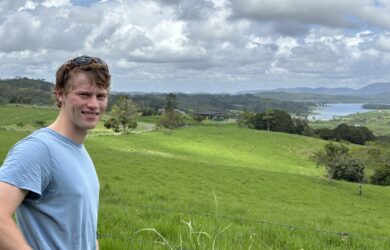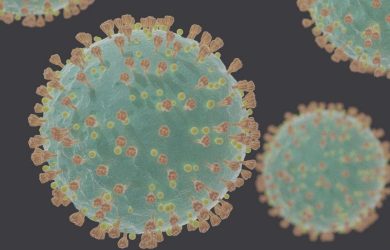
Stijn De Schepper talks about his research into what fossils can tell us about past climate change
Using ancient DNA we can look at organisms which don’t leave behind fossil shells or skeletons. That opens up an entirely new fossil record. We are just at the start and it is very exciting. We can’t see the full potential yet.
Stijn De Schepper
Stijn De Schepper is an ancient detective. His job is to investigate past climate change through working his way down the ocean bed, starting with today’s sediment and moving back through thousands of years of Earth’s history.
He maps ancient marine sediments to find out if, why and how the environment changed in the past. Over time he has developed better tools to do this and is now using DNA preserved in marine sediments to understand the basics of ocean, ecosystem and climate change. While the world rightly focuses on climate change mitigation and adaptation, Stijn – Gates Cambridge’s first paleo-climatologist – is very clear that there is still a lot more to learn about the fundamentals of our oceans and climate history. The impact his research will have is difficult to fathom, but it is an essential part of the jigsaw if we are to understand the bigger picture of our climate history.
Early days
But where did Stijn’s intellectual journey begin and how has it developed along the way?
Stijn was born in Bruges and grew up in a small village in Belgium. An only child, his father worked as a government surveyor and his mother as a nurse. As a young child, he was a good all-round student and enjoyed learning new things. He particularly liked science and would stare at world maps and dream of being in different places.
Yet because it was not really on the curriculum he didn’t become interested in geology until his last year of school, although he recalls being fascinated about the ocean and its life from watching the famous Jean-Jacques Cousteau documentaries. In his final year at school, Stijn started becoming more and more interested in science generally and remembers classes on rocks and stones that he found particularly fascinating. He loved the variety of Earth Science which fed his long-time interest in understanding how the Earth works.
He decided therefore to study Geology at the University of Ghent. His first two years, starting in 1996, were spent in a broad spectrum of science classes, from Chemistry to Biology, but he slowly began to focus more on Geology. He laughs, recalling how he was quite definite in his first year that he would never study palaeontology, the subject in which he is now a world expert.
Stijn benefited from an inspirational teacher who was very enthusiastic about Geology and fieldwork. He was keen to get his own experience in fieldwork so for his final-year thesis he managed to get accepted on a project in the Belgian countryside, where he used fossils to try to understand what the ocean looked like 400 million-years ago. He loved it and as he was finishing his four-year degree, Stijn decided he wanted to delve more in depth into how he could use fossils to understand climate change so he did another year at the University of Liège to qualify for an Interuniversity master’s in Plant Micropalaeontology and Palynology. His dissertation “Pliocene organic phytoplankton from Doel, northern Belgium: biostratigraphy and palaeoecology” was based on a dinoflagellate cyst study from the Deurganckdok in Doel.
Cambridge
After his master’s Stijn was looking around for PhD positions and funding. He did not immediately find them so took a role as a geologist at a dredging company. Just before starting at this company, he had contacted Professor Martin Head at the University of Cambridge’s Department of Geography, who, with Professor Phil Gibbard, was to become his supervisor. Professor Head advised him to apply for a Gates Cambridge Scholarship.
While he was waiting to hear back about his application, Stijn was sent to Dubai to look for sand as the dredging company was building a palm-shaped island there. One can’t use the fine desert sand for building islands in the sea and so they had to find and dredge sand from the sea bed. While he was in Dubai, Stijn heard that his application to Cambridge had been successful and that he had got the Gates Cambridge funding. He had already realised that working for the dredging company was not what he wanted. “It’s a different mindset,” he says. “I noticed I was asking different questions from the other geologists at the company. They asked practical questions about transporting sand while I was interested in knowing why the sediment happened to be there in the first place.”
As a student in the Quaternary Palaeoenvironments Group at Cambridge, Stijn began his PhD in 2002 by continuing his work on Pliocene phytoplankton fossils, comparing those in Belgium with sediments from the same era found at sites in the UK and the North Atlantic. He studied sediments from the Pliocene era, a time period from around five to two million years ago. “This is a fascinating time in Earth’s history, as it is the last time Earth’s climate was 2-3˚C warmer than today and also the time that the world and its fauna and flora as we know it today was shaped,” he says.
As he studied, he started to see that his work could be used to understand changes in the ocean and in climate. His studies involved a fascinating piece of detective work: by mapping the fossil material over a time interval of three million years he saw organisms appear and disappear. By comparing the fossils with the organisms that still live in the world’s oceans today, he could infer what the climate was and how it changed. For instance, some fossil organisms found in the North Sea are today only found in the tropics. Another example is that at some point in the past palm trees grew in the Arctic, showing that it must have been considerably warmer then. “Using fossils, you can build a narrative around climate change,” says Stijn. “I have long been interested in finding out how our climate has evolved.” He adds that he only came to the field by chance. “I just followed my nose and my interest and I was lucky enough to get funding,” he states modestly.
Stijn says the most interesting part of his PhD thesis was the final months where he looked at one glacial period, a geological interval of cooler global average temperature lasting thousands of years that occurred within the warm Pliocene. He wanted to find out how the fossils he was studying reacted to that change in temperature. “It’s such an enigmatic event and so much was unknown about it,” says Stijn. He published a paper on the changes in the ocean that occurred at that time, based on the fossil records, but says the more he looked into the subject the more he felt there was to know. “It’s very difficult to understand how the ocean was based on one fossil group,” he adds. “The more you study, the more complex it becomes and the more questions you have.”
Postdoctoral research
After Cambridge Stijn was offered industry jobs, but remembering his experience in the dredging company, he opted instead for a post doctoral position at the University of Bremen in Germany where he was able to study what he wanted for five years and wrote several articles linked to his PhD work. His research at Bremen focused more on the Pliocene glacial event and it was there that he says he became a paleoclimatologist, having started that transformation at Cambridge.
At the time funding was directed to understanding climate and climate change. That has evolved recently, with funding focused more on climate adaptation and mitigation. “From the past we have been trying to find out what the world looks like when it was 2-3 degrees warmer and carbon dioxide levels were similar to today’s. That’s more about big picture understanding of warm climates, rather than the rapid changes and extreme events we are already seeing today,” says Stijn.
Stijn has been on three ice breaker expeditions to the Arctic over the last few years and has seen the rapid pace of change there with his own eyes. “It’s quite astonishing to see that environment. You can see it change. Glaciers in Kongsfjorden on Svalbard have retreated several hundred metres in a three-year period. In places in the Arctic Ocean where you expect to see sea ice it just isn’t there,” he says.
His work over the last decade or so aims to provide the tools needed to map the history of sea ice in the distant past in more detail and greater breadth. After his time at Bremen he moved to the University of Bergen for more postdoctoral work, this time in partnership with industry on a CO2 storage project. The company he was working with was looking for good locations to store CO2 in sediment under the sea, but they found that what was injected in the sediments kept coming back up to the sea floor. There clearly was a need to have a better look at the geology of the area to understand why. Stijn’s work showed that they had misinterpreted the geology of the area and the sediments they were injecting CO2 into.
Ancient DNA theory
In 2014, Stijn moved to the Norwegian Research Centre where he is now research professor. He got funding from the Norwegian Research Council to work on sea ice in the Pliocene era. He and his team showed that there is sea ice in warm climates, but vastly less and different than the sea ice that exists today. It was during this time that he realised that the tools we have for understanding sea ice in the geological record could be better. He got enthusiastic about the idea of using ancient DNA stored in sediment for finding out the evolution of sea ice in the past. He had read a paper by accident which showed you could extract DNA from sea ice itself, and he wanted to explore if that DNA could be found in sediment.
Starting out small to test his ancient DNA theory with some seed funds from the Bjerknes Centre for Climate Research, followed by a larger project from the Norwegian Research Council, he got funding from the European Research Council in 2019 to scale his work up and is now Principal Investigator of the AGENSI project. The innovative project uses the genetic signature from surface water and sea ice organisms that are stored in sediments. It states: “This wealth of information has not been explored before, and requires calibration to observations and existing proxies for sea ice reconstructions.”
I’m really interested in developing a fundamental understanding of our past climate and in developing new tools to understand the history of our oceans – this knowledge from the past that can help us understand and plan for our future,” says Stijn. “Ancient DNA has bigger potential than my previous research on a single fossil group in terms of mapping biodiversity. We can get results from all organisms that lived in the ocean, from microorganisms to fish. We are finding things in the fossil record that have never been found before,” he states. “Using ancient DNA we can look at organisms which don’t leave behind fossil shells or skeletons. That opens up an entirely new fossil record in our oceans. We are just at the start and it is very exciting. We can’t see the full potential yet.”
*Picture: Stijn on a recent ice breaker expedition in the Arctic Ocean.












